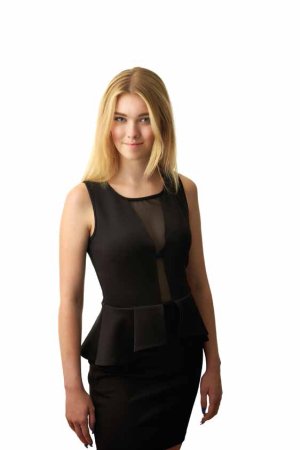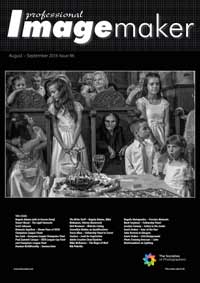articles/Lighting/one-light-rev-page1
One Light Revisited - part 1 of 1 2 3
by Dave Montizambert Published 01/08/2016

Quite a few years ago, December 2005 in fact, I wrote an article for Professional Imagemaker on how one could create a portrait with a pure white background and do so with just one light. The goal of this one light set-up is to create a pure white background, (250 Levels or higher in all three channels) off a neutral coloured wall or backdrop while creating a soft forgiving light quality on the subject and doing so with a nicely exposed flesh-tone. In this current article I would like to revisit this concept and redo it but only this time do it 'blind'. Blind you ask? Well blind in the sense of no modelling light, in fact do it as a strobist using an off-camera flash. In addition to this I'll take it one step further and do it with my old, I mean really old, Vivitar 285 camera flash from the 1970s. Yeah it still works, really well in fact, although the front diffuser has yellowed a little but then who doesn't with age, besides camera flash is not a thing I need so I never updated. Crazy thing was, I popped new batteries in it after letting it sit unused for a good 20 years and away it went! So why the camera flash approach? Well partially to prove that it's not the equipment, it's the knowledge. You can do this set-up with very inexpensive gear if you are prepared to work a lot harder than you would with the right stuff. Also you can pick up oldies like my Vivitar for next to nothing and I've been teaching one-light set-ups as part of my lighting training repertoire for a long time now. A high percentage of the photographers I teach only have camera flash to work with and aren't going to buy into a studio set-up any time soon because they rarely shoot in studios and don't command the budgets to buy, haul, and set up the serious stuff on location.
Camera flash has two really distinct disadvantages to studio strobes. For the sake of portability you have to give up power. Camera flash is pathetic in terms of power compared to the average studio strobe and they often cost more than an entry level studio strobe which is easily three or more times the power. The second disadvantage: complete and utter blindness, that is lack of modelling light - you can't see where the light is falling making my one-light pure-white background portrait set-up seem impossible. But nothing is impossible to the eternal optimist and so with my glass half full let's get it on! (...is that akin to half sober as opposed to half cut?).
The number one trick to this one light set-up involves distance; it works so much easier if you can place the flash further away so that the respective distances of the background and subject somewhat even out by perspective. If you take a look at diagram D in Image 02, you'll notice that the Vivitar flash (in technical speak the 'Origin'), sits about 2 to 2.5 metres (6 to 8ft) away from the subject. I was fortunate that the room I was shooting in was large. You can do it in closer like 1.7 metres (5ft) without too much trouble, but further is easier. Setting up on an angle to the background as seen in the set-up diagram, really helps to even out the background. Obviously the challenge of lighting a background with only one light is that one side of background is always going to be closer to the light than the other side. If things are really bad, you can place a gobo up close to the flash to create a very gradual soft shadow-edge onto the nearest/brightest side of the background to drop its exposure by a bit. Working with a longer lens helps too; the longer the lens the narrower the field of view which means that less background (or wall in our case) will appear in the captured image behind the subject.
You are currently on page 1 Contact Dave Montizambert
1st Published 01/08/2016
last update 09/12/2022 14:57:08
More Lighting Articles
There are 17 days to get ready for The Society of Photographers Convention and Trade Show at The Novotel London West, Hammersmith ...
which starts on Wednesday 14th January 2026





